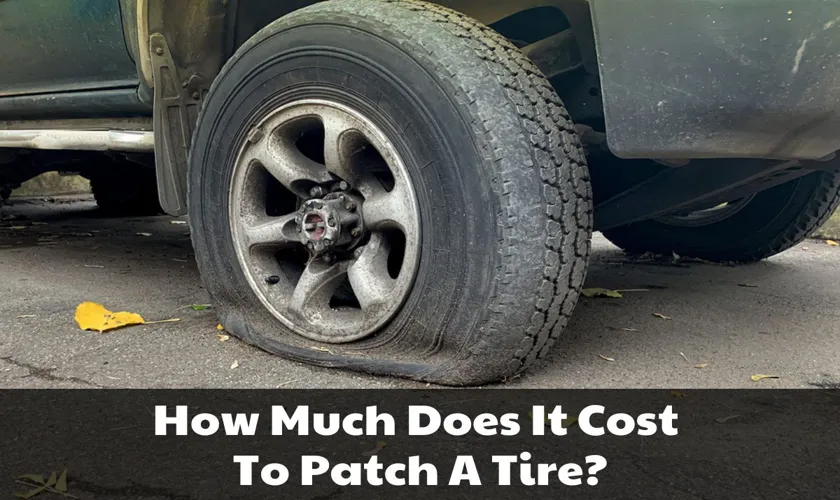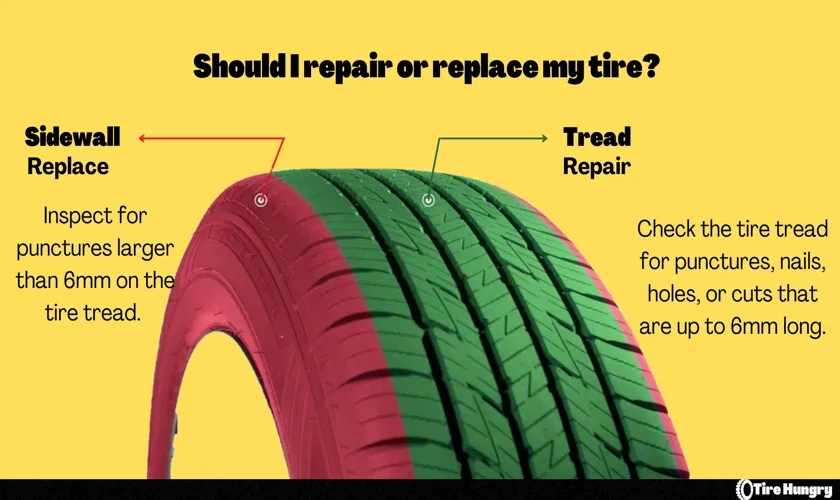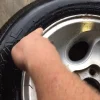Have you ever experienced a flat tire that could potentially leave you stranded on the road? It can be a stressful situation that needs immediate attention. But what if the tire can be patched up instead of replaced? The question is, how much does it cost to patch up a tire? The cost of patching up a tire depends on various factors, such as the type of tire, the location of the puncture, and the severity of the damage. In general, the average cost of patching up a tire ranges from $15 to $30.
However, if the puncture is located on the sidewall or at the edge of the tread, it may not be patchable, and a replacement would be necessary. It is important to note that a patched tire may not guarantee the same level of performance and safety as a new tire. A patch may compromise the tire’s integrity, and it may not be recommended for high-speed driving or long distances.
Therefore, it is crucial to consult with a professional mechanic to assess the safety and viability of patching up a tire. In a nutshell, patching up a tire can be a cost-effective solution depending on the severity of the damage. It is always best to prioritize safety and seek professional advice to ensure the best outcome.
Table of Contents
Factors Affecting Tire Patching Cost
If you’re looking to patch up a tire, the cost can vary depending on several factors. One of the biggest factors is the size of the tire. Bigger tires will generally cost more to patch than smaller ones.
Another consideration is how deep or severe the damage is; some punctures may only require a simple patch, while others may require a full tire replacement. Additionally, the type of tire can also impact the cost. For example, run-flat tires are generally more expensive to patch than regular tires.
Finally, where you go to get the tire patched up can also make a difference. Big brand dealerships may charge more, while smaller independent shops may offer more competitive pricing. All these factors should be taken into account when considering how much it will cost to patch up a tire.
Overall, the cost to patch up a tire can range from $20 to $40 for a simple patch to $100 or more for a more complex repair or replacement.
Size and type of tire
When it comes to patching a tire, there are several factors that can affect the cost. One of these factors is the size and type of tire. Generally speaking, larger tires tend to be more expensive to patch because they require more time, effort, and materials to repair.
This is because larger tires are thicker and have more surface area, which means there is more damage that needs to be repaired. Additionally, the type of tire can also impact the patching cost. For example, run-flat tires can be more expensive to patch than standard tires because they require special equipment and expertise to repair.
Overall, the size and type of tire are important factors to consider when determining the cost of tire patching.

Severity of the damage
When it comes to patching a tire, the cost can vary based on a number of factors. One of the most important factors is the severity of the damage. If you have a small puncture or hole in your tire that can easily be patched, the cost will likely be much lower than if you have a large tear or other extensive damage.
Additionally, the cost may also depend on the type of tire you have and the age of the tire. Newer tires may be more expensive to patch than older tires, and certain types of tires, such as run-flat tires, may also be more costly to repair. Ultimately, the cost of patching a tire will be determined by the specific circumstances of your situation, so it’s important to work with a reputable tire repair shop to get an accurate estimate.
Location and labor costs
When it comes to the cost of tire patching, location and labor costs are two major factors to consider. The location of the tire repair shop can greatly affect the price you pay for patching a tire. In urban areas, the cost is generally higher due to higher overhead and rent costs.
Additionally, labor costs can vary based on the skill level of the technician performing the repair. More specialized and experienced workers may cost more, while less experienced workers may cost less. However, it is important to keep in mind that the cheapest option may not always be the best option.
Prioritizing quality and safety should always be the top concern when it comes to tire patching. At the end of the day, the cost of patching a tire is a small price to pay for ensuring the safety and longevity of your vehicle.
Average Cost of Tire Patching
If you’ve found yourself with a punctured tire, you might be wondering how much it will cost to patch it up. The good news is that tire patching is generally a less expensive option than purchasing a brand new tire. On average, you can expect to pay anywhere from $10 to $30 for a tire patch repair, depending on the location of the puncture and the type of tire you have.
Of course, this estimate can vary depending on where you live and where you take your vehicle for the repair. It’s important to note that in some cases, patching a tire may not be possible and replacement may be required. If you’re unsure of the damage to your tire, it’s always best to consult a professional for guidance on the best course of action.
Patch plug repair cost: $10-$30
Tire patching can be an affordable option to fix a flat, but it’s important to know the average cost of this service to avoid overpaying. On average, a tire patch plug repair can cost anywhere from $10 to $30, depending on the size and location of the puncture. This method involves inserting a rubber patch into the hole, then using a special tool to secure it in place.
It’s a quick and easy process that can usually be done in less than an hour. If the puncture is too large or in an unsafe location, tire patching may not be an option, and a new tire may be necessary. Additionally, it’s important to check your tire pressure regularly to prevent future flats and extend the lifespan of your tires.
Overall, tire patching can save you money and get you back on the road quickly, but it’s always best to consult with a trusted mechanic to determine the best solution for your specific situation.
Patch plug with patch repair cost: $20-$40
When it comes to flat tires, patching them up is a cost-effective option that will get you rolling again without breaking the bank. The average cost of tire patching typically ranges between $20 to $40, depending on the type of patch plug used and the repair process involved. A patch plug is a simple solution that involves inserting a rubber plug into the puncture hole, plugging it up and sealing it with a strong adhesive.
While it is important to have a professional technician handle the repair, patching a tire is a quick and easy process that can be completed within an hour. Patching your tire is a wise decision, as it is considerably cheaper than replacing the tire entirely and allows you to extend the life of your tires. This cost-effective solution saves you money in the long run and ensures that you can keep driving without having to worry about the inconvenience of a flat tire.
So, the next time you find yourself with a flat tire, consider patching it up and getting back on the road in no time!
Patch and plug radial tire repair cost: $20-$50
When it comes to tire troubles, patching up a radial tire is often the most cost-effective solution. The average cost of tire patching ranges from $20 to $50, which is considerably less than the cost of replacing a worn-out tire altogether. Whether it’s a puncture due to a nail or some other sharp object, a skilled technician can usually patch and plug radial tires with ease.
While the cost may vary depending on the extent of the damage and the region you live in, tire patching is generally a straightforward procedure that can be done quickly to get you back on the road in no time. Keep in mind that not all tire damage can be patched up, however, as some punctures may be too large or located in critical areas for a patch to be effective. If you’re unsure about the extent of your tire damage, it’s always a good idea to take it to a professional who can advise you on the best course of action.
When to Repair or Replace a Tire?
When you spot a punctured or leaking tire, you may wonder whether it’s better to repair or replace it. The cost to patch up a tire can vary depending on the extent of the damage. In general, a simple nail hole or puncture can often be repaired with a patch or plug, which typically costs between $10 to $30.
However, if the tire is severely damaged, it may need to be replaced altogether, which can cost upwards of $100 or more. Additionally, factors such as the age and tread depth of the tire, as well as the type of vehicle you have, can all play a role in the decision to repair or replace a tire. It’s always best to consult with a trusted mechanic or tire professional to determine the best course of action for your unique situation.
Tire age and wear
Tire age and wear Have you ever wondered when it’s time to repair or replace a tire? It can be a tricky decision, but there are some key factors to consider. One of the most important is tire age. Even if your tires look like they’re in good shape, they may be past their prime if they’re several years old.
The rubber on tires can dry out and crack over time, which can lead to a blowout or other tire failure. In general, it’s a good idea to replace tires that are more than six years old, regardless of their condition. Another important factor is tire wear.
If your tires are worn down to the point where the tread is less than 2/32 of an inch deep, it’s time to replace them. You can check this easily by using a penny – just insert it into each groove with Lincoln’s head upside down. If you can see the top of his head, your tread is too low.
Don’t take chances with worn or aged tires – your safety on the road depends on them.
Tire sidewall damage
Tire sidewall damage can be a frustrating issue for car owners. The sidewall of a tire is the area that connects the tread to the bead, and it is where many issues can arise. Small cuts or punctures in the sidewall may be repairable, but larger or more severe damage will require the tire to be replaced.
It’s essential to check the condition of your tires regularly, as sidewall damage can be dangerous. If left unaddressed, sidewall damage could lead to a blowout while driving, which can be extremely dangerous. Additionally, driving on tires with sidewall damage can cause the tire to wear unevenly, leading to poorer performance and reliability.
When you notice any damage to the sidewall of your tire, it’s best to take your car to a reputable tire shop and have a professional inspection. They can determine if the tire can be repaired or if it needs to be replaced. It’s always better to err on the side of caution when it comes to tire safety, so don’t ignore any signs of sidewall damage.
Tread depth and puncture size
When it comes to determining whether to repair or replace a tire, the condition of its tread depth and the size of the puncture are critical factors to consider. Tires with low tread depth can increase the risk of hydroplaning or losing traction, resulting in reduced control of the vehicle. The general rule is to replace tires that have a tread depth of less than 2/32 of an inch.
Some states have legal requirements for minimum tread depth, and failure to meet these regulations can result in fines or tickets. Punctures or cuts in tires larger than ¼ of an inch are usually not repairable and are signs that it’s time to replace the tire. That’s because larger punctures can cause extensive damage to the tire structure, making it unsafe to repair.
Additionally, multiple punctures in the same tire or sidewall damage are not repairable either. It’s also crucial to check the age of tires since they age and degrade over time, regardless of the mileage they’ve accumulated. In conclusion, the decision to repair or replace a tire depends on several factors.
Tread depth and puncture size are two of the primary considerations used to determine whether it’s safe to repair or whether a tire is beyond repair and needs replacement. As a vehicle owner, it’s essential to have regular tire inspections and monitor your tires’ condition to ensure your safety and prolong the life of your tires. Safe travels!
Conclusion
So, how much does it cost to patch up a tire? Well, it really depends on the severity of the damage and the type of tire. But what’s certain is that the cost of neglecting a punctured tire can lead to bigger and more expensive problems down the road. Investing in a quick and affordable patch can save you not only money but also helps keep you and your precious cargo safe.
As they say, a stitch in time saves nine – or in this case, a patch in time saves a lot of dimes!”
FAQs
What is the average cost to repair a tire puncture?
The average cost to repair a tire puncture is around $20 to $30.
Can a tire with a sidewall puncture be repaired?
No, a tire with a sidewall puncture cannot be repaired and must be replaced.
How long does it take to patch up a tire?
On average, it takes around 30 minutes to patch up a tire.
What is the difference between a tire patch and a tire plug?
A tire patch is a permanent repair that requires the tire to be removed from the wheel, while a tire plug is a temporary fix that can be done while the tire is still on the wheel.
Can you drive on a patched tire?
Yes, you can drive on a properly patched tire. However, it is recommended to have the tire inspected by a professional before driving on it.
Does insurance cover tire repair costs?
It depends on your insurance policy. Some policies may cover tire repair costs, while others may not.
What are some common causes of tire punctures?
Some common causes of tire punctures include driving over sharp objects, hitting a curb or pothole, and general wear and tear on the tire.



